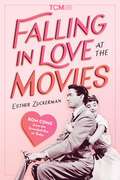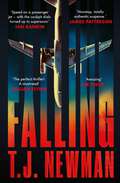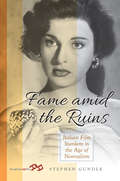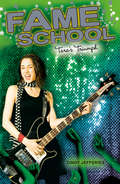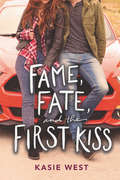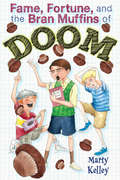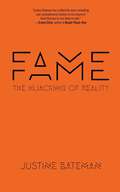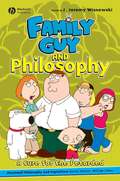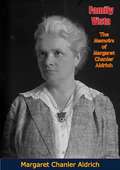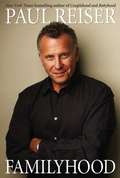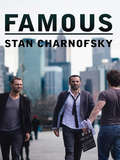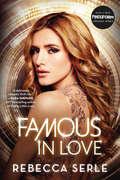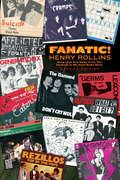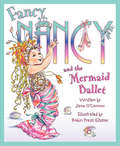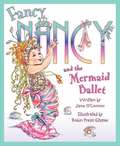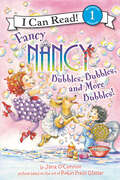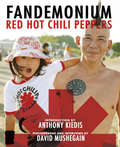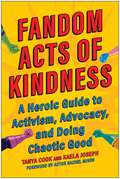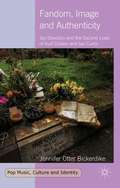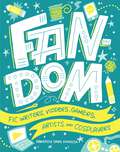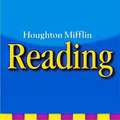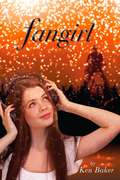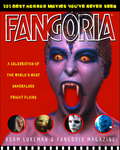- Table View
- List View
Falling in Love at the Movies: Rom-Coms from the Screwball Era to Today (Turner Classic Movies)
by Esther ZuckermanPrepare to swoon, ugly cry, laugh, and fall in love with this officially licensed exploration of the impact and legacy of one of film's most beloved genres from Turner Classic Movies: the rom-com. Romantic comedies have had an incredible influence on popular culture, shaping everything from how we think of relationships to fashion. Often swept aside in film history, these movies are thought of as pure comfort viewing. Although they certainly provide those fuzzy feelings, they have also had a significant artistic influence and cultural impact. Spanning decades of romantic comedies—from movies of the 1930s such as It Happened One Night and the rom com craze of the 80s and 90s including When Harry Met Sally...all the way to contemporary hits like Crazy Rich Asians, and everything in between—Falling in Love at the Movies will make you fall in love (all over again) with romantic comedies. Esther Zuckerman—accomplished entertainment journalist and member of the New York Film Critic&’s Circle—takes readers on a journey through the rom-com. She examines the aspects that make us so drawn to these types of films, diving deep into the key auteurs—from Preston Sturges to James L. Brooks to Nora Ephron and beyond—who both created and subverted the canon. These directors, actors, and writers shaped the genre, establishing and also busting traditional pillars and tenets of these movies such as the &“Perfect Pair&” or &“The Man in Crisis&” and &“The High Maintenance Woman.&” Featuring full-color images from the films throughout, along the way Zuckerman takes detours, explores iconic lines of dialogue (Who could forget Julia Roberts' &“I&’m also just a girl, standing in front of a boy, asking him to love her&” iconic moment from Notting Hill?) to memorable scenes (the magical moment at the Empire State Building in Sleepless in Seattle) and weaves in interviews of artists and romantic comedy fanatics in the industry. Looking beyond the traditional rom-com, Zuckerman digs into the nooks and crannies, the films that buck the trend of "happily ever after," the ones that think beyond heteronormative narratives, and the indies that kept the rom-com alive outside of the studio system, to offer a more comprehensive story of the rom-com than has ever been seen before—and one that you&’re bound to love. How&’s that for a happy ending?
Falling: the most thrilling blockbuster read of the summer
by T. J. NewmanPRE-ORDER THE PAPERBACK EDITION OF DROWNING, THE THRILLING NEW BLOCKBUSTER BY T. J. NEWMAN. OUT JUNE 2024. &‘Amazing . . . Intense suspense, shocks and scares plus chilling insider authenticity make this one very special&’ LEE CHILD 'FALLING is the best kind of thriller (for me as a reader anyway). Characters you care deeply about. Nonstop, totally authentic suspense' JAMES PATTERSON&‘Attention, please: T. J. Newman has written the perfect thriller! GILLIAN FLYNN, #1 bestselling author of Gone GirlYou just boarded a flight to New York.There are one hundred and forty-three other passengers onboard.What you don&’t know is that thirty minutes before the flight your pilot&’s family was kidnapped.For his family to live, everyone on your plane must die.The only way the family will survive is if the pilot follows his orders and crashes the plane. Enjoy the flight. ***Praise for Falling*** &‘Think Speed on a passenger jet - with the cockpit dials turned up to supersonic&’ Ian Rankin &‘Stunning and relentless. This is Jaws at 35,000 feet&’ Don Winslow &‘The best thriller I&’ve read in years. Buckle up&’ Adrian McKinty &‘Attention, please: T. J. Newman has written the perfect thriller! ... Terrific and terrifying, a true page-turner.. A must-read for summer vacation' Gillian Flynn, #1 bestselling author of Gone Girl &‘A jet-propelled thriller that will have you in its grip from first page to last. A truly astonishing debut and an incredible work of pure suspense&’ Steve Cavanagh 'Newman keeps up an extreme pace from the first page—a near-impossible task, considering that the hero is locked in a cockpit, unable to take action himself. This novel is like the films Die Hard and Speed on steroids, creating one of the year&’s best thrillers' Library Journal &‘With characters you&’ll root for and a plot that dips and bounces like a plane hitting turbulence, this thrill ride is impossible to put down&’ Daily Mail &‘A scorching thriller&’ Evening Standard 'Newman&’s [flight attendant] background means Falling brings a freshness and depth to the genre' The Guardian 'A superlative debut . . . This tense, convincing thriller marks the arrival of an assured new talent' Publishers Weekly ' ...full of the kind of authentic detail that comes from personal experience' Literary Review &‘Gripping from the first sentence, this thriller is like no other&’ OK! Magazine 'A remarkable debut' The Sunday Times '... a tense and claustrophobic read, the fast-paced action zipping along at an astonishing rate' Refinery29
Fame Amid the Ruins: Italian Film Stardom in the Age of Neorealism
by Stephen GundleItalian cinema gave rise to a number of the best-known films of the postwar years, from Rome Open City to Bicycle Thieves. Although some neorealist film-makers would have preferred to abolish stars altogether, the public adored them and producers needed their help in relaunching the national film industry. This book explores the many conflicts that arose in Italy between 1945 and 1953 over stars and stardom, offering intimate studies of the careers of both well-known and less familiar figures, shedding new light on the close relationship forged between cinema and society during a time of political transition and shifting national identities.
Fame Amid the Ruins: Italian Film Stardom in the Age of Neorealism
by Stephen GundleItalian cinema gave rise to a number of the best-known films of the postwar years, from Rome Open City to Bicycle Thieves. Although some neorealist film-makers would have preferred to abolish stars altogether, the public adored them and producers needed their help in relaunching the national film industry. This book explores the many conflicts that arose in Italy between 1945 and 1953 over stars and stardom, offering intimate studies of the careers of both well-known and less familiar figures, shedding new light on the close relationship forged between cinema and society during a time of political transition and shifting national identities.
Fame School #5 (Tara's Triumph)
by Cindy JeffriesTara is following her dream of becoming a bass guitar rock star. But when roommates Pop and Lolly tell her about an African school for orphans, Tara decides that helping others is more important than becoming famous. <P><P>A charity CD seems like a great way to raise money, since Tara is surrounded by talented friends and teachers at Rockley Park school. But before long, she realizes that the CD is much more work, and trouble, than she bargained for. Tara needs a lot of help--and a little ingenuity--to pull it all together. Will she succeed? Or will all her hard work be wasted?
Fame, Fate, and the First Kiss
by Kasie WestFan favorite author Kasie West delivers an effervescent story about chasing your dreams and following your heart, perfect for fans of Jenny Han and Huntley Fitzpatrick. Lacey Barnes has dreamed of being an actress for as long as she can remember. So when she gets the opportunity to star in a movie alongside one of Hollywood’s hottest actors, she doesn’t hesitate to accept the part.But Lacey quickly learns that life in the spotlight isn’t as picture perfect as she imagined. She’s having trouble bonding with her costars, her father has hired the definition of a choir boy, Donavan Lake, to tutor her, and somewhere along the way she’s lost her acting mojo. And just when it seems like things couldn’t get any worse, it looks like someone on set is deliberately trying to sabotage her. As Lacey’s world spins out of control, it feels like the only person she can count on—whether it’s helping her try to unravel the mystery of who is out to get her or snap her out of her acting funk—is Donavan. But what she doesn’t count on is this straight-laced boy becoming another distraction.With her entire future riding on this movie, Lacey knows she can’t afford to get sidetracked by a crush. But for the first time in her life Lacey wonders if it’s true that the best stories really do happen when you go off script.
Fame, Fortune, and the Bran Muffins of Doom
by Marty KelleySimon's latest scheme is to gain everlasting fame and glory by winning the school talent show. What stands in his way? A lot. There's the fact that he doesn't sing, dance, or play a musical instrument. There's nasty Mike McAlpine and his cronies. There's Stacy and her distracting brown eyes. And last, but certainly not least, is Mrs. Annand, who insists on bombarding Simon and his friends with dangerously hard muffins while they rehearse their act. Utter humiliation is looking a lot more likely than fame and glory for Simon's band, The Groovy Guys.
Fame, Glory, and Other Things on My To Do List
by Janette RallisonIt's been a week and a half since Brendan broke up with me, but I try not to think about him. He only crosses my mind when I see Lauren and him walking around the hallways holding hands, or when they eat lunch in the cafeteria sitting so close together you'd think they were Siamese twins, or when I cry myself to sleep every night. But besides all of that, I'm doing really well. On the night I met Jordan, I wasn't thinking about Brendan at all. After my shift at Wal-Mart was over, I walked out into the parking lot debating the merits of boy names for girls instead of dwelling on the fact that it was Friday night and Brendan and Lauren were out somewhere practicing their Siamese twins routine.
Fame: The Hijacking of Reality
by Justine BatemanA passionate and critical analysis of the life cycle of Fame, from film producer/director and former worldwide TV star Justine Bateman. “Wholly riveting.” —New York Times Book Review “Justine Bateman was famous before selfies replaced autographs, and bags of fan mail gave way to Twitter shitstorms. And here’s the good news: she took notes along the way. Justine steps through the looking glass of her own celebrity, shatters it, and pieces together, beyond the shards and splinters, a reflection of her true self. The transformation is breathtaking. Revelatory and raucous, fascinating and frightening, Fame is a hell of a ride.” —Michael J. Fox, actor, author of A Funny Thing Happened on the Way to the Future Entertainment shows, magazines, websites, and other channels continuously report the latest sightings, heartbreaks, and triumphs of the famous to a seemingly insatiable public. Millions of people go to enormous lengths to achieve Fame. Fame is woven into our lives in ways that may have been unimaginable in years past. And yet, is Fame even real? Contrary to tangible realities, Fame is one of those “realities” that we, as a society, have made. Why is that, and what is it about Fame that drives us to spend so much time, money, and focus to create the framework that maintains its health? Mining decades of experience, writer, director, producer, and actress Justine Bateman writes a visceral, intimate look at the experience of Fame. Combining the internal reality-shift of the famous, theories on the public’s behaviors at each stage of a famous person’s career, and the experiences of other famous performers, Bateman takes the reader inside and outside the emotions of Fame. The book includes twenty-four color photographs to highlight her analysis.
Family Guy and Philosophy: A Cure for the Retarded
by J. Jeremy WisnewskiWisnewski (philosophy, Hartwick College) provides the analysis and some of the funny footnotes as he and his contributors work through postmodernism, religion and religious exclusivity, virtue and perversity, clueless men (in the character's case this is an oxymoron), motherhood, deadly sins, the importance of background people, dogs with personality, the logic of expectation, humor, fallacies, plagiarism, will and wantonness in wives, ego, and death. The result is fun, if you are a fan of the show, but even if you are not, you can get the point and most of the jokes.
Family Vista: The Memoirs of Margaret Chanler Aldrich
by Margaret Chanler AldrichFirst published in 1958, these are the memoirs of Margaret Chanler Aldrich, a descendant of the prominent Astor family. A nurse for the American Red Cross during the Spanish-American War, and later the Philippine-American War, Aldrich joined the woman’s suffrage movement and became notable as one of Carrie Chapman Catt’s capable officials in the campaign for suffrage in New York State.A fascinating autobiography!
Familyhood
by Paul ReiserFor the longest time, based on no evidence other than our own insecurity and sense of incompetence, my wife and I were convinced that we were the flat-out, no-question-about-it, least-skilled parents in the country. Furthermore, we were convinced that every other set of parents we knew was perfect. They were more thorough in going over their kids' homework, they set better boundaries than we do, didn't let their kids watch as many hours of TV as we do, raised kids who are unfailingly polite in public and have a far greater sense of community and public service than our underachieving offspring over there on the couch watching SpongeBob. We were certain everybody else's kids willingly and joyfully eat nothing but healthy foods, shunning all candy and candy-based products, they all sensibly and automatically put on weather-appropriate clothing, and voluntarily call their grandparents with clockwork regularity, giving fully detailed accounts of their numerous accomplishments, ending with testimonials to their wonderful and perfect parents.Turns out: not so much. At all.In the number one New York Times bestseller Couplehood, Paul Reiser wrote about the highs and lows of falling in love and getting married-and the heartbreak and hilarity that comes with it. In Babyhood, he turned his sharply observant eye to the experiences of having a brand-new family. And now in Familyhood, Reiser shares his observations on parenting, marriage, and mid-life with the wit, warmth, and humor that he's so well-known for.From the first experience of sending his two boys off to summer camp-the early feelings of gleeful freedom in an empty house, to realizing how empty the house actually was-to maneuvering the minefield of bad words learned at school, this hilarious new book captures the spirit of familyhood, the logical next frontier for Reiser's trademark perspective on the universal truths of life, love, and relationships.
Famous
by Stan CharnofskyWealthy, mega-successful parents reared Harry Schiff to hunger for fame and fortune. At college he sees others throw off family fiats and successfully begin to define themselves. He meets Juliet, driven to be an actor, sensuous, passionate, yet never with commitment. His good friend, Katy Bloom, also a striving actor, becomes his confidante, secretly in love with him. A fourth buddy, Galen Thurston, an Adonis, blessed with Hollywood connections, gets a seeming break because of his father, but with strings. A tragedy explodes when Galen discovers his father’s ugly secret. The group’s chemistry is altered with an intrigue that involves both Harry’s and Galen’s parents. Juliet is on her rocket to fame, her own family’s tale so sordid that she cannot tolerate her father’s presence. Is Harry Juliet’s toy? She would deny it, but eventually, Harry must face off his two demons: his parents’ domination and Juliet’s emotional indifference. Resolution comes when he gets a heady break, screws up his courage to confront his issues, and sees Katy Bloom in another light. To be true to himself becomes more important than to become famous.
Famous in Love
by Rebecca Serle"A must-read for anyone curious about life and love behind the scenes."--Bella Thorne, actor and author of Autumn FallsWhen seventeen-year-old Paige Townsen gets plucked from obscurity to star in the movie adaptation of a blockbuster book series, her life changes practically overnight. Within a month, Paige has traded the quiet streets of her hometown for a bustling movie set on the shores of Maui, and she is spending quality time with her costar Rainer Devon, one of People's Sexiest Men Alive. But when troubled star Jordan Wilder lands the role of the other point in the movie's famous love triangle, Paige's crazy new life begins to resemble her character's. In this coming-of-age romance inspired by the kind of celeb hookups that get clever nicknames and a million page views, Paige must figure out who she is -- and who she wants -- while the whole world watches.
Fanatic!
by Henry RollinsIn 2004, when legendary Los Angeles radio station Indie 103.1 asked Henry Rollins to host a show, he jumped at the chance. He chose the name "Harmony in My Head," based on his favorite Buzzcocks tune. As lead man for Black Flag, Rollins was present at the raw beginnings of punk and knew many of its stars. But Rollins' taste encompassed more than punk, and the show became a cult favorite featuring artists as disparate as the Stooges, Miriam Makeba, the Simpletones, Slim Galliard, and the Weirdos. An inspired Rollins began compiling extensive annotations for each song he played, a mix of history, anecdote, and Rollins's trademark trenchant opinions. His show can still be heard online in streaming audio, and his notes live on in this irresistible collection.
Fancy Nancy and the Mermaid Ballet (Fancy Nancy)
by Jane O'Connor*NOW A HIT TV SERIES ON DISNEY JUNIOR*From the dazzling bestselling duo Jane O’Connor and Robin Preiss Glasser comes a fancy, frilly ballet story with a lot of heart. Young ballerinas and Fancy Nancy fans will shout encore!Fancy Nancy is ready for the spotlight! Fancy Nancy and her best friend, Bree, couldn't be more excited about their upcoming dance show. After all, it's all about mermaids, and who knows how to be a fancy, glamorous mermaid better than Fancy Nancy herself?But when another ballerina wins the coveted role of the mermaid, Nancy is stuck playing a dreary, dull tree. Can Nancy bring fancy flair to her role, even though it isn't the one she wanted? And when disaster strikes right before the big ballet, who will step into the spotlight? Perfect for fans of the Eloise and Olivia books. Ooh la la! Fancy Nancy is starring in her own fabulous TV show on Disney Junior. READ THE BOOKS THAT STARTED IT ALL!Fancy NancyFancy Nancy and the Posh PuppyFancy Nancy: Bonjour, ButterflyFancy Nancy: Splendiferous ChristmasFancy Nancy and the Fabulous Fashion BoutiqueFancy Nancy and the Mermaid BalletFancy Nancy: Fanciest Doll in the UniverseFancy Nancy and the Wedding of the CenturyFancy Nancy 10th Anniversary EditionFancy Nancy: Saturday Night SleepoverFancy Nancy: Oodles of Kittens
Fancy Nancy and the Mermaid Ballet (I Can Read!)
by Jane O'Connor<P>Fancy Nancy is ready for the spotlight! <P>Fancy Nancy and her best friend, Bree, couldn't be more excited about their upcoming dance show. After all, it's all about mermaids--and who knows how to be a fancy, glamorous mermaid better than Fancy Nancy herself? But when another ballerina wins the coveted role of the mermaid, Nancy is stuck playing a dreary, dull tree. <P>Can Nancy bring fancy flair to her role, even though it isn't the one she wanted? And when disaster strikes right before the big ballet, who will step in to steal the spotlight? <P>From bestselling duo Jane O'Connor and Robin Preiss Glasser comes a fancy, frilly ballet story with a lot of heart. Tiny fans will shout "Encore!" Picture descriptions present.
Fancy Nancy: Bubbles, Bubbles, and More Bubbles! (I Can Read Level 1)
by Jane O'ConnorFancy Nancy and her class are going to see The Big Bubble Show!Nancy and Bree can’t wait to go. But when Bree gets sick and has to miss the show, Nancy decides to put on a bubble show of her own. Will Nancy and her classmates be able to put on the best bubble show ever?From the beloved New York Times bestselling author-illustrator team Jane O’Connor and Robin Preiss Glasser, Fancy Nancy: Bubbles, Bubbles, and More Bubbles is a Level One I Can Read, perfect for children learning to sound out words and sentences.
Fandemonium: Red Hot Chili Peppers
by David Mushegain Anthony KiedisOne-of-a-kind tribute from one of the best-selling bands in the world direct to their legions of fans.<P><P> The Red Hot Chili Peppers' performances have become legendary as much for the music and antics on stage as the generous, loving community of people who stand side by side, screaming their approval. This is a fan appreciation book from the band that puts the emphasis where it should be--on the fans. A vivid montage of words from the band members to their fans, it includes hundreds of photos taken at concerts worldwide, and interviews with fifty of the most devoted RHCP fans around the globe. The stories that emerge range from fantastic to tragic, but always inspirational and life-affirming. Lead singer Anthony Kiedis--New York Times best-selling author of his memoir, Scar Tissue--writes about the making of this book, and tells the story of the band's connection with their fans from day one in 1983 and how that relationship has evolved over three decades. Designed with a DIY/fanzine feel, this book is more than a fan tribute; it's a cultural exchange that captures the unique connection of an iconic band as devoted to their fans as the fans are to them.
Fandom Acts of Kindness: A Heroic Guide to Activism, Advocacy, and Doing Chaotic Good
by Tanya Cook Kaela JosephFandom can save the world! This first of its kind, actionable and inspirational resource provides the tools and motivation necessary for pop culture fans to make a difference—while having fun! Fandoms are united as a community because of the power of story. And it&’s exactly the magical alchemy forged when mixing story and community that has helped fandoms across the world feed thousands of hungry children, donate countless books, build schools, register voters, disrupt online hate speech, and save lives through crafting PPE for COVID-19 frontline workers, natural disaster response, and mental health crisis support. Fandom Acts of Kindness not only tells the stories of the good fans have done in the world but serves as a dungeon master&’s guide to how to be a hero yourself. Perfect for those who want to inspire others, organize collective action, sustain, and nurture your own mental health and creativity, and do it all through a pop culture perspective.
Fandom, Image and Authenticity
by Jennifer Otter BickerdikeKurt Cobain and Ian Curtis. Their early and unexpected deaths propelled them to iconic status, as beacons for the values of individuality and authenticity. However, with each passing year, the images of the lead men become further removed from their original humanity. From Converse to cake, this book examines how their 'brands' lend credibility to commerce, while the increasing worth placed on the singers provides a modern example of a secular belief system propelled by media, technology and the value of immediacy in the 2. 0 world. Journeys to spaces and places associated with the two singers are akin to pilgrimages, sacred trips that hope to capture and connect with the very essences that the men have been stripped of in their ever-widening appeal. Within this context, Curtis and Cobain become guides and Anglicised role models in the search for personal identity and community in the modern uncertain world.
Fandom: Fic Writers, Vidders, Gamers, Artists, and Cosplayers
by Francesca Davis DiPiazzaHave you ever finished a book or TV series and wished for more? Created stories, art, or videos based on a game? Dressed up as your favorite character? If so, you've entered fandom. Fan writers expand and mix up stories, like sending the Star Trek crew to Hogwarts. Cosplayers sew Star Wars and Sailor Moon costumes, and fan filmmakers make music video tributes. Fans also enrich invented worlds with greater diversity, creating female and multiracial avatars for games peopled only with white male characters. Tour fandom's history and meet fan writers, video-makers, artists, costumers, and gamers who celebrate the things they love and shape fan communities online and in real life.
Fanfare for Food (Houghton Mifflin Harcourt Vocabulary Readers #Leveled Reader: Level: 5, Theme: 2.2)
by Gary MillerThe story of a boy who uses his musical talent to help fight hunger in Vermont.
Fangirl
by Ken BakerWhile staring you straight in the eye, far above the tips of her Toms, Josie Brant would swear that she does not like Peter Maxx, the teen sensation who causes every girl within a 100-foot radius to scream at ear-shattering decibels. Even if Josie may completely, totally, and unequivocally be his biggest fan. So when Josie finds out her best friend has won a contest to meet Peter by stealing one of Josie’s songs, Josie is overwhelmingly shocked and upset-some of which flies out the window when Ashley introduces Josie to Peter as well. And suddenly, in a whirlwind of Tweets, IMs, texts, and phone calls, Josie finds herself in the middle of a flirtatious friendship that has the potential for complete harmony. But just when everything seems pitch-perfect, the paparazzi flashbulbs explode, along with any notion of a fairy-tale romance. Author Ken Baker, E! Channel’s Chief News Correspondent, uses his inside knowledge to craft a novel authentic to the teen pop idol experience with sincere heart and humor.
Fangoria's 101 Best Horror Movies You've Never Seen
by Adam LukemanA FEAST OF FRIGHTFUL FLICKS WAITING TO BE REDISCOVEREDAs the leading name in the world of horror, Fangoria magazine has been the source of information for fans of fright flicks for more than twenty years--covering feature films, video games, comic books, collectibles, and all aspects of horror entertainment. Working closely with Fangoria's experts, including Editor in Chief Anthony Timpone, Adam Lukeman has compiled a must-have guide for casual horror fans and hardcore horror junkies with Fangoria's 101 Best Horror Films You've Never Seen. With a brief synopsis for each of the included films, lists of cast and crew, "Terror Trivia," and little-known facts about these lesser-known but must-see gems, Fangoria's 101 Best Horror Films You've Never Seen offers a feast of gruesome information. Featured here are flicks that were dumped by their distributors or were initially flops, like Cherry Falls, Manhunter, and Pumpkinhead, foreign winners such as Cronos, The Vanishing, and Funny Games, and straight-to-video sleepers waiting to be discovered, including Shadowbuilder, Jack Be Nimble, and Nomads. There are even surprise entries directed by industry giants--movies like George A. Romero's Day of the Dead, Brian De Palma's Sisters, or Dario Argento's Opera--that are frequently overshadowed by the filmmakers' other, better-known works but are worthy of further examination. Entertaining and informative, Fangoria's 101 Best Horror Movies You've Never Seen offers more than a hundred reasons to look beyond the often ho-hum Hollywood hype fests . . . when you're really in the mood to feel your flesh crawl.From the Trade Paperback edition.
